

Aktif öğretim yöntem ve teknikLeri. AKTİF ÖĞRETİM YÖNTEM VE TEKNİKLERİ ( kaynak ) Kavram Haritaları: Kavram haritaları bilginin zihinde somut olarak düzenlenmesini sağlayan bir araçtır.
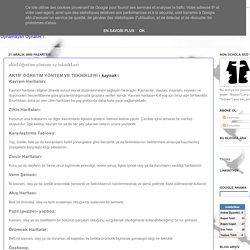
Kavramlar, olayları, insanları, eşyaları ve düşünceleri benzerliklerine göre gruplandırdığımızda gruplara verilen isimdir. Kavram haritaları 6-8 yaş için biraz ağır bir tekniktir. Sınırlılıkları daha az olan zihin haritaları bu yaş grubunda daha fazla yarar sağlamaktadır. Zihin Haritaları: Konunun ana noktalarını ve diğer kavramlarla ilişkisini gösterir. Karşılaştırma Tablosu: Yaş, özellik, liste ya da kavramların belirli yönergelere göre benzerlik ya da farklılıklarının belirlenmesi amacıyla hazırlanmış çizelgelerin karşılaştırıldığı tablolardır. Zincir Haritaları: Konu ya da olayların bir birine zincir biçiminde eklendiği, neden sonuç ilişkisi içinde olay ya da durumların verildiği haritalardır. Venn Şeması: İki kavram, olay ya da özellik arasındaki benzerlik ve farklılıklarının belirlenmesinde ve şema şeklinde ifade edilmesinde kullanılır. 1.
The Picture Book Buzz - Interview with Daniel Miyares. Today is Little Fox in the Snow's book birthday!
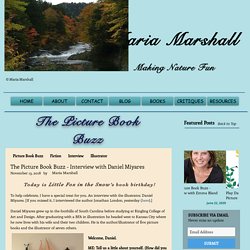
To help celebrate, I have a special treat for you. An interview with the illustrator, Daniel Miyares. [If you missed it, I interviewed the author Jonathan London, yesterday (here).] Çağdaş Drama Derneği. Dramada Rol Oynama ve Doğaçlama Teknikleri 25 YARATICI DRAMA ÖRNEĞİ - Etkinliklerle Türkçe Öğretim - TÜRKÇE ÖĞRETİMİ, YABANCILARA TÜRKÇE ÖĞRETİMİ. | Gösterim: 708547 A1 ve A2 KURLARINDA UYGULANABİLECEK Restoranda Kişiler: Çok aç ama parasız biri / Tok ama paralı biri / Hem aç hem paralı biri / Yorgun ve sinirli bir garson P Gönüllü dört öğrenci seçin.
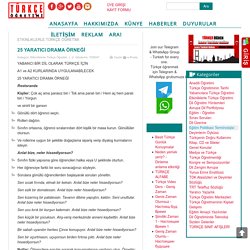
P Rolleri dağıtın. P Sınıfın ortasına, öğrenci sıralarından dört kişilik bir masa kurun. P Ve rollerine uygun bir şekilde doğaçlama sipariş verip diyalog kurmalarını isteyin Anlat bize, neler hissediyorsun? P Sınıfın fiziki yapısına göre öğrencileri halka veya U şeklinde oturtun. P Her öğrenciye farklı bir soru soracağınızı söyleyin. P Sorulara gönüllü öğrencilerden başlayarak soruları yöneltin. Sen sıcak fırında, elmalı bir keksin. Sen ezik bir domatessin. Sen kızarmış bir patatessin. Dramatic Elements. The 12 Dramatic Elements These twelve dramatic elements are at the core of all drama.
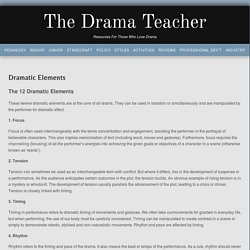
They can be used in isolation or simultaneously and are manipulated by the performer for dramatic effect. Drama Toolkit - Drama Games. Creative Drama Lesson Plans. Complete Drama. 4 Simple Drama Techniques for Teaching English. Do you want to get your students up on their feet, energized and excited to learn?

Want to give them a chance to goof around together, have fun, make mistakes, laugh and move forward—all while building resiliency and community? Want to allow students who aren’t always great at academics to stand out, displaying their physical skills, artistry and ability to “ham it up”? Then introduce some drama into your English teaching! And even if you aren’t a ham yourself, or don’t feel like you could act your way out of a paper bag, you can easily use these techniques in your classroom.
I’ll share four very simple ways to use drama with ESL students, which you can adopt and adapt to fit your own teaching. A dramatic-inquiry approach to teaching and learning. Tolga Şirin.
When Statues Come Alive: Teaching and Learning Academic Vocabulary Through Drama in Schools - Cannon - 2017 - TESOL Quarterly. Creative ideas for teaching drama. DRAMA in ENGLISH LANGUAGE TEACHING: A WHOLE-PERSON LEARNING APPROACH. Introduction What is Drama in ELT?
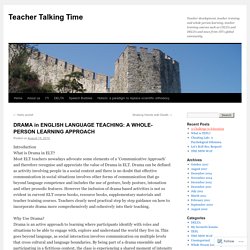
Most ELT teachers nowadays advocate some elements of a ‘Communicative Approach’ and therefore recognise and appreciate the value of Drama in ELT. Drama can be defined as activity involving people in a social context and there is no doubt that effective communication in social situations involves other forms of communication that go beyond language competence and includes the use of gesture, body posture, intonation and other prosodic features. The Hub - ICEBREAKERS to help participants get to know each other and better engage in an activity - Orthodox Church in America. By Nicholas Finley When holding a retreat, conference, or any gathering it is important for everyone to stretch their social muscles in order to engage in the event with the proper positive attitude about the activity.
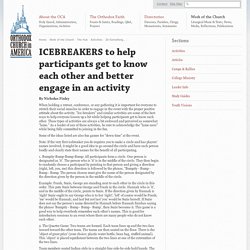
"Ice-breakers" and similar activities are some of the best ways to help everyone loosen up a bit while helping participants get to know each other. These types of activities are always a bit awkward and perceived as somewhat "lame. " As a leader of any of these activities, be sure to acknowledge the "lame-ness" while being fully committed to joining in the fun.
Some of the ideas listed are also fun games for "down time" at the event. Note: If the very first icebreaker you do requires you to make a circle and has players' names involved, it might be a good idea to go around the circle and have each person loudly and clearly state their names for the benefit of all participating. 1. Susanhillyard.
25 YARATICI DRAMA ÖRNEĞİ - TÜRKÇE ÖĞRETİMİ, YABANCILARA TÜRKÇE ÖĞRETİMİ. Contacts - David Heathfield. Drama in Education. (*This article appeared in the Youth Theatre Journal, 9, 92-96, March, 1995) (Re-published on website, August 2, 2002) "Mental hygiene" refers to approaches to preventive psychiatry through the development of habits of self-care.
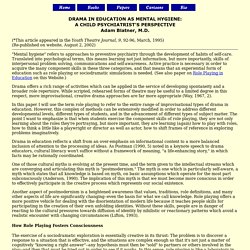
Translated into psychological terms, this means learning not just information, but more importantly, skills of interpersonal problem solving, communications and self-awareness. Active practice is necessary in order to acquire the many component skills in these three categories, and that means that an experiential form of education such as role playing or sociodramatic simulations is needed. (See also paper on Role Playing in Education on this Website.) Drama offers a rich range of activities which can be applied in the service of developing spontaneity and a broader role repertoire. Osu1149082511. Process Drama in Education. Webpage Supplement to Chapter 9: Gustave J.
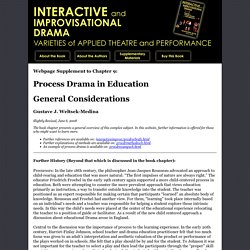
Weltsek-Medina Slightly Revised, June 6, 2008 The book chapter presents a general overview of this complex subject. In this website, further information is offered for those who might want to learn more. Why Teach Drama? If you are like me, you frequently find yourself trying to justify your existence as a Drama teacher.
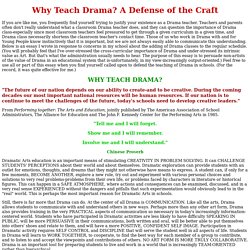
Teachers and parents often don't really understand what a classroom Drama teacher does, and they can question the importance of Drama class-especially since most classroom teachers feel pressured to get through a given curriculum in a given time, and Drama class necessarily shortens the classroom teacher's contact time. Those of us who work in Drama with and for Young People know instinctively that it is important, but we are not always easily able to communicate this understanding. Below is an essay I wrote in response to concerns in my school about the adding of Drama classes to the regular schedule. Role Playing in Education. (First written in 1995, and corrected October 18, 2009) Role playing, a derivative of a sociodrama, is a method for exploring the issues involved in complex social situations. It may be used for the training of professionals or in a classroom for the understanding of literature, history, and even science.
(See also paper on use of Drama in Education on this website.) The great developmental psychologist, Jean Piaget, described two modes of learning: "assimilation" and "accommodation. " In assimilation, people figuratively "fill in" their mental map of their world, while in accommodation, they figuratively change that mental map, expand or alter it to fit their new perceptions. Both processes are complementary and concurrent, but different types of learning tend to emphasize one or the other mode. Drama - Activities. Role Playing | Improvisation | Dance | Mime | Sociodrama | Masks Role Playing Ask children to spend 5 mins thinking about what they would like to be,.e,g prime minister, famous character, slave, and ask them to act it out.
Acting in pairs Think up a pair of characters, e.g two nurses, two burglars, two astronauts in space, etc. and they have to work out how to work together . Top Improvisation: Examples of activities for under 10's : Okul Öncesi Drama Örnekleri – Çocuklara Şarkılar. Bu güzel şarkıyı paylaşın. Advantages and Disadvantages of Using Drama in an EFL Classroom. The advantages of using drama/theatre in an EFL classroom can be summarized as follows: · It increases students’ motivation, participation, confidence and fluency in the spoken English as well as communication through the body language. · It extends the emotional range of expressions. · It develops creativity and spontaneity. · It provides opportunities for group and self-expression. · It promotes confidence, trust, cooperation and group cohesion.
Boudreault - The Benefits of Using Drama in the ESL/EFL Classroom. The Internet TESL Journal Chris Boudreaultsolartrees [-at-] gmail.com(Lac La Biche, Canada) As an English teacher, I have often been amazed at how effective drama is to capture the attention of the students in the ESL/EFL classroom. Drama activities would sometimes have surprising and unexpected results. ESL/EFL professionals need to use this medium more because the artificial world of the classroom can be transformed into a quasi-real language situation and provides an endless amount of opportunities for student’s personal growth. We cannot only teach grammar and phonetics with drama but also it has the power to transform the actors as well as the audience.
Process Drama in Education. Wilfrid Gordon Mcdonald Partridge. Giyotine Kahkahalarıyla Meydan Okuyan Kadın: Cezayirli Cemile. Verb-Adverb Charades. Subjects Arts & Humanities --Language Arts --Theater Arts Grade [facebookbadge] Brief Description Verbs and adverbs take center stage in this lively activity. BBC Two - Seeking Refuge, Ali’s journey from Afghanistan (animation) IDEA 2017 Conference Drama. IDEA, IDEATURKEY, Çağdaş Drama Derneği, Ankara, Drama, Theatre ideaturkey.org International Drama, Theatre and Education Association (IDEA), 9 th WORLD CONGRESS, IDEA 2017. Ankara, Turkey, July 10-16, 2017. Congress Theme Circle IDEA www.ideadrama.org. IDEA, IDEATURKEY, Çağdaş Drama Derneği, Ankara, Drama, Theatre. Acting Out, in a Good Way! 5 Sensational ESL Drama Activities. It has been widely argued that speech makes up only a fraction of human communication. The researcher Albert Mehrabian famously broke it down as follows: 55% of communication is through body language, 38% is tone of voice and a mere 7% relies on the meaning of the actual words themselves!
Regardless of the actual figures, it’s abundantly clear that much of our communication is non-verbal. Facial expressions, hand gestures and body language are essential elements of how we communicate with one another. MA Drama Education and English Language Teacher (ELT) DRAMA in ENGLISH LANGUAGE TEACHING: A WHOLE-PERSON LEARNING APPROACH. Yaratıcı Drama Dergisi. Çocuk Oyunları Derlemesi/Drama İçin 27 Pratik Oyun Yaratıcı Drama Alanında Peter Slade’in Drama Anlayışının İncelenmesi. Oluşum Drama Enstitüsü. Prof. YaRatıcı Drama: EĞİTİMDE YARATICI DRAMA. Çağdaş Drama Derneği. Creative ideas for teaching drama. Çağdaş Drama Derneği. Oyun Kavramından Daramaya Daramadan Dramatik Eğitime Nurhan Tekerek. Eğitimde Yaratıcı Drama İnci San. Chauhan - Drama Techniques for Teaching English. Bir Eğitim Tekniği Olarak Drama. Drama Teknikleri - Drama Eğitimi Kursu. YaRatıcı Drama: Temel Drama Teknikleri NeLerdir ?